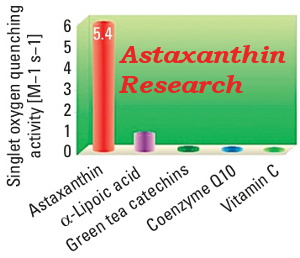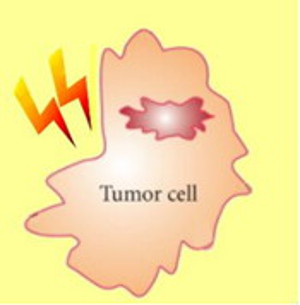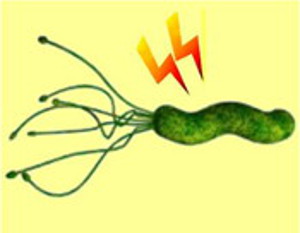 Astaxanthin Research
Astaxanthin Research
Here is some Astaxanthin research (primarily carried out on animals due to the newness of Astaxanthin):
First of all, It’s Safe
Trial results reveal that 6 mg of astaxanthin per day from a H. pluvialis algal extract can be safely consumed by healthy adults. Safety of an astaxanthin-rich Haematococcus pluvialis algal extract: a randomized clinical trial. J Med Food. 2003
Anti-inflammatory
Anti-inflammatory effect of 100 mg/kg AST (Astaxanthin) was as strong as that of 10 mg/kg prednisolone. AST also decreased production of NO, activity of inducible nitric oxide synthase (NOS), and production of PGE2 and TNF-alpha in RAW264.7 cells in vitro in a dose-dependent manner. CONCLUSIONS: This study suggests that AST has a dose-dependent ocular anti-inflammatory effect, by the suppression of NO, PGE2, andTNF-alpha production, through directly blocking NOS enzyme activity. Effects of astaxanthin on lipopolysaccharide-induced inflammation in vitro and in vivo. Invest Ophthalmol Vis Sci. 2003
Beneficial Effects in Diabetes
Results indicate that astaxanthin can exert beneficial effects in diabetes, with preservation of beta-cell function. This finding suggests that anti-oxidants may be potentially useful for reducing glucose toxicity. Astaxanthin protects beta-cells against glucose toxicity in diabetic db/db mice. Redox Rep. 2002
More Astaxanthin Research Gems
- Astaxanthin Reduces Damage From Exercise ~ Astaxanthin can attenuate exercise-induced damage in mouse skeletal muscle and heart, including an associated neutrophil infiltration that induces further damage. Astaxanthin limits exercise-induced skeletal and cardiac muscle damage in mice. Antioxid Redox Signal. 2003.
 Antitumor
Antitumor
- Astaxanthin Improves Antitumor Immune Responses ~ We investigated the effects of astaxanthin on the antitumor effector activity of natural killer (NK) cells suppressed by stress in mice in order to define the immunological significance of astaxanthin (ASX) when combined with restraint stress treatment. Daily oral administration of ASX (1 mg/kg/day, p.o., 14 days) markedly attenuated the promotion of hepatic metastasis induced by restraint stress.
- These results suggested that astaxanthin improves antitumor immune responses by inhibiting of lipid peroxidation induced by stress. Contribution of the antioxidative property of astaxanthin to its protective effect on the promotion of cancer metastasis in mice treated with restraint stress. Life Sci. 2002.
- Astaxthin Protects Your Liver ~ Results suggest that astaxanthin protects liver from damage induced by CCl4 by inhibiting lipid peroxidation and stimulating the cellular antioxidant system. Effect of astaxanthin on the hepatotoxicity, lipid peroxidation and antioxidative enzymes in the liver of CCl4-treated rats. Methods Find Exp Clin Pharmacol. 2001.
- Astaxanthin is Twice as Effective as Beta-carotene ~ Astaxanthin being about 2-fold more effective than beta-carotene. The efficient antioxidant activity of astaxanthin is suggested to be due to the unique structure of the terminal ring moiety. Efficient radical trapping at the surface and inside the phospholipid membrane is responsible for highly potent antiperoxidative activity of the carotenoid astaxanthin. Biochim Biophys Acta. 2001.
 Lowers h.pylori levels
Lowers h.pylori levels
- Astaxanthin Lowers Levels of h.pylori (Associated with Gastric Malignancies) ~ Helicobacter pylori infection in humans is associated with chronic type B gastritis, peptic ulcer disease, and gastric carcinoma.
- A high intake of carotenoids and vitamin C has been proposed to prevent development of gastric malignancies…
- Five mice from each group were sacrificed 1 day after the cessation of treatment, and the other five animals were sacrificed 10 days after the cessation of treatment. Culture of H. pylori and determination of the inflammation score of the gastric mucosae were used to determine the outcome of the treatment.
- Mice treated with astaxanthin-rich algal meal or vitamin C showed significantly lower colonization levels and lower inflammation scores than those of untreated or control-meal-treated animals at 1 day and 10 days after the cessation of treatment. Lipid peroxidation was significantly decreased in mice treated with the astaxanthin-rich algal meal and vitamin C compared with that of animals not treated or treated with the control meal.
- Both astaxanthin-rich algal meal and vitamin C showed an inhibitory effect on H. pylori growth in vitro.
- In conclusion, antioxidants may be a new strategy for treating H. pylori infection in humans. Astaxanthin-rich algal meal and vitamin C inhibit Helicobacter pylori infection in BALB/cA mice. Antimicrob Agents Chemother. 2000.
- Astaxanthin Reduces Gastric Inflammation ~ Helicobacter pylori (h.pylori) is a gram-negative bacterium affecting about half of the world population, causing chronic gastritis type B dominated by activated phagocytes.
- In some patients the disease evolves into gastric ulcer, duodenal ulcer, gastric cancer or MALT lymphoma.
- The pathogenesis is in part caused by the immunological response. In mouse models and in human disease, the mucosal immune response is characterized by activated phagocytes…
- The aim of the present study was to investigate whether dietary antoxidant induced modulation of H. pylori in mice affected the cytokines produced by H. pylori specific T-cells.
- We found that treatment of H. pylori infected mice with an algal cell extract containing the antioxidant astaxanthin reduces bacterial load and gastric inflammation. Treatment of H. pylori infected mice with antioxidant astaxanthin reduces gastric inflammation, bacterial load and modulates cytokine release by splenocytes. Immunol Lett. 1999.
- Results indicate that dietary astaxanthin suppressed Meth-A tumor cell growth and stimulated immunity against Meth-A tumor antigen. Antitumor activity of astaxanthin and its mode of action. Nutr Cancer. 2000[/spoiler]
- Astaxanthin Inhibits Growth of Mammary Tumors ~ Beta-carotene, canthaxanthin and especially astaxanthin inhibit the growth of mammary tumors in mice; their anti-tumor activity is also influenced by the supplemental dose. A comparison of the anticancer activities of dietary beta-carotene, canthaxanthin and astaxanthin in mice in vivo. Anticancer Res. 1999.
- Astaxanthin Provides Superior UVA Light Protection ~ Beta-Carotene, lutein and astaxanthin protect against UVA light-induced oxidative stress in vitro with astaxanthin exhibiting superior protective properties. Modulation of UVA light-induced oxidative stress by beta-carotene, lutein and astaxanthin in cultured fibroblasts. J Dermatol Sci. 1998.
- Astaxanthin Has Chemopreventive Effects in Oral Carcinogenesis ~ The chemopreventive effects of two xanthophylls, astaxanthin (AX) and canthaxanthin (CX) on oral carcinogenesis induced by 4-nitroquinoline 1-oxide (4-NQO) was investigated in male F344 rats.
- Rats were given 20 ppm of 4-NQO in their drinking water for 8 weeks to induce oral neoplasms or preneoplasms. Animals were fed diets containing 100 ppm AX or CX during the initiation or postinitiation phase of 4-NQO-induced oral carcinogenesis. The others contained the groups of rats treated with AX or CX alone and untreated.
- At the end of the study (week 32), the incidences of preneoplastic lesions and neoplasms in the oral cavity of rats treated with 4-NQO andAX or CX were significantly smaller than those of rats given 4-NQO alone (P < 0.001).
- In particular, no oral neoplasms developed in rats fed AX and CX during the 4-NQO exposure and in those given CX after the 4-NQO administration.
- Similarly, the incidences of oral preneoplastic lesions (hyperplasia and dysplasia) in rats treated with 4-NQO and AX or CX were significantly smaller than that of the 4-NQO-alone group (P < 0.05).
- In addition to such tumor inhibitory potential, dietary exposure of AX or CX decreased cell proliferation activity in the nonlesional squamous epithelium exposed to 4-NQO as revealed by measuring the silver-stained nucleolar organizer regions protein number/nucleus and 5′-bromodeoxyuridine-labeling index. Also, dietary AX and CX could reduce polyamine levels of oral mucosal tissues exposed to 4-NQO.
- These results indicate that AX and CX are possible chemopreventers for oral carcinogenesis, and such effects may be partly due to suppression of cell proliferation. Chemoprevention of rat oral carcinogenesis by naturally occurring xanthophylls, astaxanthin and canthaxanthin. Cancer Research 1995.
Dr. Mercola points out the following about Astaxanthin and Eye Health:
- GREATLY protects your eyes from cataracts, macular degeneration, and blindness
- Science is now revealing that astaxanthin may be the ULTIMATE carotenoid for eye health and prevention of blindness. Blindness is an enormous problem worldwide.
- Clinical studies tell us that photic injury from the cumulative effect of repeated “photic insults” and the resulting gradual loss of photoreceptor cells is a major cause of Age Related Macular Degeneration (ARMD).
- Scientists have studied lutein, zeaxanthin, canthaxanthin, and astaxanthin for their respective abilities to protect the retina. But none functions to the degree that astaxanthin does.
- Dr. Mark Tso of the Wilmer Eye Institute at Johns Hopkins has demonstrated that astaxanthin is the winner when it comes to protecting your eyes. He discovered that astaxanthin easily crosses into the tissues of the eye and exerts its effects safely and with more potency than any of the other carotenoids, without adverse reactions.
- Specifically, Tso determined astaxanthin could ameliorate or prevent light induced damage, photoreceptor cell damage, ganglion cell damage, and damage to the neurons of the inner retinal layers.
- Read more.
Free Trials:
Join Amazon Channels Free Trial
Try Amazon Music Unlimited 30-Day Free Trial
Join Amazon Kindle Unlimited 30-Day Free Trial
Try Amazon Prime 30-Day Free Trial
Join HBO Free Trial
Join Amazon Prime Music - The Only Music Streaming Service with Free 2-day Shipping - 30-day Free Trial
